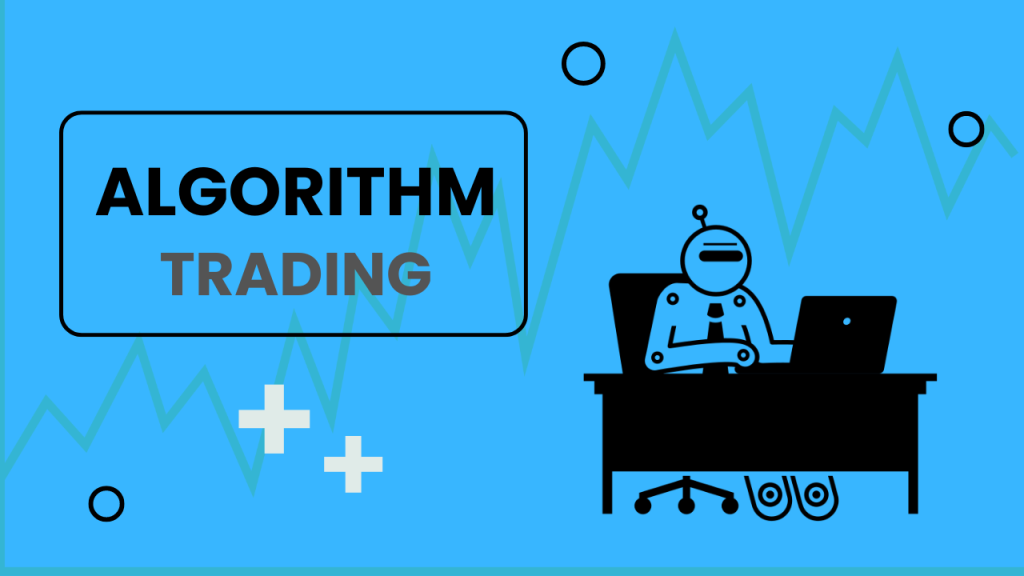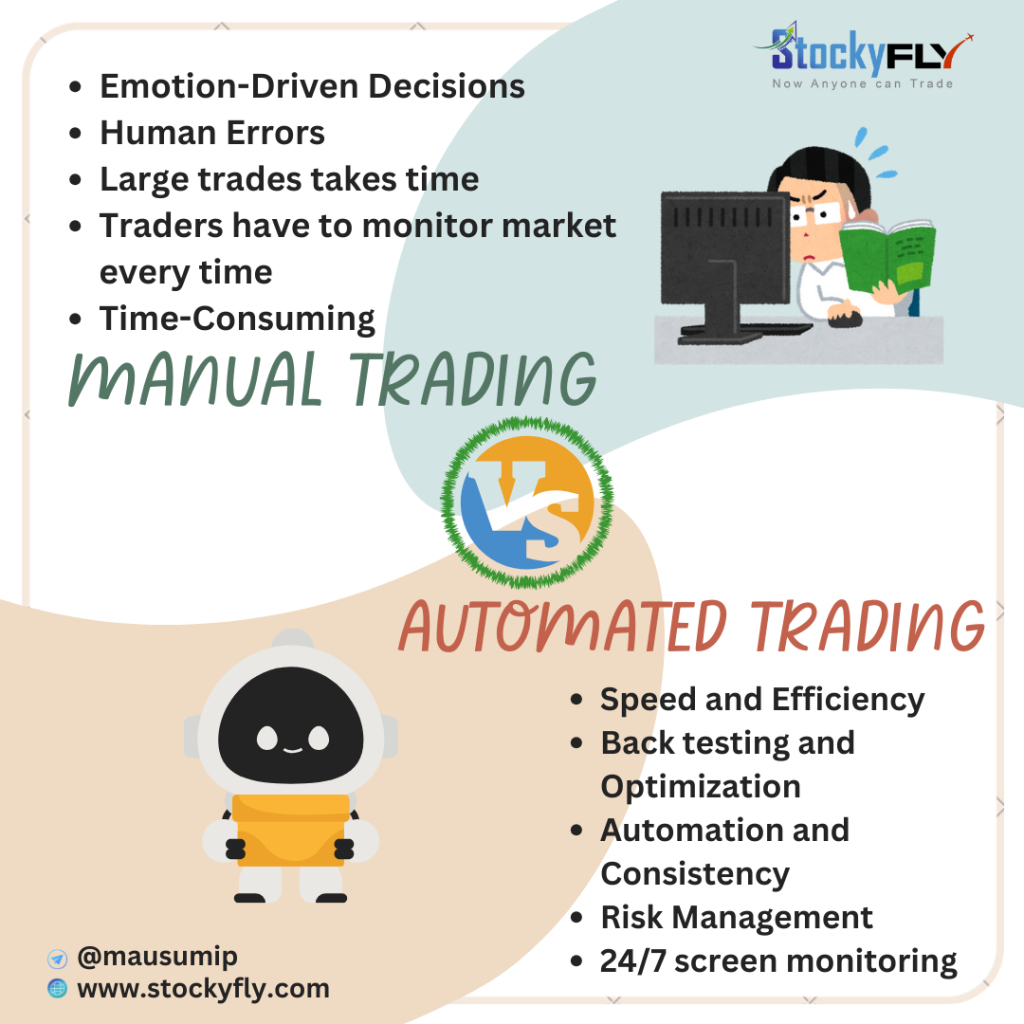Algorithmic Trading Software

Pros
1. Speed and Efficiency
- Algorithms operate very quickly, executing trades based on predefined conditions to minimize delays and increase overall trading efficiency.
- Algorithms in trading eliminate emotional biases that can impact manual trading.
- This lack of emotions guarantees a consistent strategy and reliable decision-making by not being influenced by human sentiments.
2. Back testing and Optimization
- Algorithms can be back tested using historical data, allowing traders to optimize strategies and fine-tune parameters for better performance.
- Ability to implement complex strategies involving multiple parameters, indicators, and variables for precise decision-making.
3. Automation and Consistency
- Trading occurs automatically based on predefined criteria, eliminating the need for constant monitoring and enabling 24/7 trading.
- For instance,” Stockyfly Algos” presents Originals, which are pre-built trading algorithms meticulously crafted by experienced industry experts.
- These strategies, derived from extensive research, cater to diverse market conditions and effectively shield your capital from the impact of inflation.
- Algorithms execute trades with unwavering consistency, strictly adhering to the defined trading strategy without any deviations or inconsistencies.
- By adhering strictly to pre-programmed rules, algorithms maintain a disciplined approach to trading, thereby avoiding impulsive decisions or deviations from the established strategy. This unwavering consistency guarantees reliability and stability in trading outcomes, standing the test of time.
4. Risk Management
Automated stops and limits are used in algo management strategies. This automated approach ensures that risk mitigation actions are executed in a timely manner without the need for manual intervention.
Cons
1. Technical Knowledge Requirement
- trading to traders without programming skills. They provide no-code algorithms that can be effectively used by anyone.
- This accessibility is beneficial for people who want to engage in trading strategies ,Platforms like Stockyfly Algos in India offer a solution for algos without coding expertise.
- Even with automation, algorithms still need regular monitoring for glitches or market changes that may require adjustments.
2. Over-Optimization and Data Dependence
- Strategies overly tailored to outdated data can result in overfitting.
- Relying only on historical data might not consider unforeseen market events or rapid changes in market dynamics.
- Depending solely on this data poses a risk because markets can evolve differently, potentially impacting the algorithm’s performance in real-time trading.
3. Higher Costs
- Algorithmic trading, or algo trading, needs special software, which can be costly. Traders might have to purchase or license algorithmic trading platforms, data feeds, and proprietary software for strategy development.
- Developing algorithms requires skilled programmers proficient in coding languages like Python, C++, or specialized platforms like MetaTrader.
- Acquiring historical market data from reliable sources involves subscription fees or one-time purchases. In India.
- Trading algorithms need continuous refinement and updates to adapt to changing market conditions. This ongoing maintenance requires time, effort, and sometimes hiring experts.
- Operating algo trading systems requires robust hardware setups, including servers, high-speed internet connections, and backup systems. All of these factors contribute to the overall expenses of algo trading.
Examples Algo trading
Let us take example of a trader named Ram who uses algorithms while executing trades.
Ram uses moving averages to decide when to buy or sell stocks. He only buys a stock if its 30-day average price goes above the 180-day average, and he sells if the 30-day average price goes below the 180-day average. He has programmed this requirement into a computer software, which will handle the time, price, and volume of the stock automatically, freeing him from having to track business opportunities and changes.
Manual Trading

Pros
1. Flexibility and Adaptability
- Traders can quickly adjust to market changes using intuition, news, and analysis, which algorithms may not always take into account.
- Manual traders can use various trading strategies, adapting to the current market situation.
2. Emotional Intelligence and Intuition
- Skilled manual traders can avoid making impulsive decisions based on fear or greed, unlike automated algo trading systems.
- Human traders can perceive subtle market changes and make intuitive judgments that automated systems might miss because they rely on predefined algorithms.
Cons
1. Emotion-Driven Decisions
- Emotions can influence trading decisions, causing inconsistencies and errors.
- Manual trading can be mentally tiring and affect decision-making over time.
2. Time-Intensiveness and Subjectivity
- Constantly watching markets can be time-consuming, especially for day traders, limiting the ability to focus on other aspects of life.
- Traders interpret market signals and data differently, which can cause subjective analysis and inconsistent outcomes.
Which method best suits your goals?

When assessing the method, keep in mind these steps for a well-considered decision:
- It’s important to understand the difference between algo trading and manual trading.
- Algo trading uses automated rules to analyze the market, while manual trading involves personal analysis and trade execution.
- Your approach is key. If you prefer a hands-off strategy, algo trading may be suitable for you. But if you enjoy analysis and making decisions, manual trading might be a better fit.
- Trading requires skills like market analysis and decision-making. Evaluate your strengths and weaknesses in these areas to choose the method that suits you best.
- Algo trading needs technical expertise and specialized software, while manual trading requires less technical know-how but more time and effort.
- Consider your resources like time, money, and technical skills to decide which is feasible for you.
- Before deciding, try both methods with small investments to see which aligns better with your profitability goals.
- Both algo trading and manual trading have their own advantages and disadvantages. The choice often depends on individual preferences, skills, and objectives.
- Some traders may use a combination of both methods. It’s crucial to understand the pros and cons to make informed decisions aligned with your goals and preferences.
- Additionally, seek advice from experienced traders or financial professionals to gain insights into the pros and cons of each approach. Making an informed decision will set you up for success in your trading journey.



